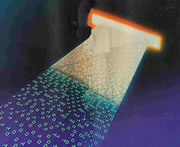| |

Banks and billers face a muddled environment of electronic and paper-based processes.
The latest technology merges mixed payments and streamlines conventional transactions.
|
|
|
|
The Changing Face of Billing
The Changing Face
of Billing
"The typical paper-based billing process is made up
of a series of time-honored steps handled in sequence by various manual and
computer-aided methods. First a firm's billing information is aggregated, stored
and sourced for billing data. Then actual paper bills are printed, mailed and
delivered. When received by customers, these bills are then reviewed, exceptions
are noted and contact with payees may be necessary to resolve differences. Next,
checks are written, records are maintained, postage is applied and payments
are delivered. Finally, the biller and the payer's bank or financial institution
exchanges payment data for mainstream account reconciliation." Buy Now,
Pay Now: Internet-Enabled Billing Comes of Age," Zona Research,
March 2001.
Sounds complicated, huh? It's expensive, too. The round-trip
cost of generating a single paper bill, invoice or other form of remittance
and processing the payment and paperwork that comes back is approximately $1.90.
Remittance technology providers are chipping away at payment
processing costs with better automation software, and more powerful optical
and intelligent character recognition engines. But the best way to cut the cost
of billing is to do it all electronically. Analysts such as Jupiter Communications
estimate that billers could save almost 80 percent (for paper, postage, handling)
per payment, approximately $1.20 per bill, by using electronic bill presentment
and payment (EBPP). U.S. businesses could save nearly $18 billion per year.
What's Taking EBPP
So Long?
So, why isn't this already done? All the stakeholders agree
that EBPP is going to be huge. So huge, in fact, that everyone is wrestling
to keep control over as much the data as they possibly can. As a result, billers
now receive no more than 12 percent to 18 percent of their payments electronically,
according to Zona, Redwood City, CA.
Further adding to the difficulty is the fact that consumers
and the businesses that service those consumers have very different views about
the best way to handle electronic bill presentment and payment. Consumers and
businesses want their banks to be the organizations that consolidate bills online.
Banks would be glad to do so, but the credit card companies, telecommunications
companies, utilities and retailers that send out bills are not eager to release
valuable customer information to financial institutions.
One solution the this dilemma is to setup independent consolidators
that can route bills and payments between large numbers of stakeholders. A fair
number of small business and financial institutions without the resources to
set up their own payment network have expressed interest in such an approach.
Larger billers just don't want to cede control of their existing customer data
and customer interactions. To do so takes away the potential of a great many
cross-selling and upselling opportunities.
"Banks were smart to stay away from EBPP for a year
or two until the smoke cleared," says Errol Hau, director of product marketing
at CheckFree, a leading provider of electronic billing and payment services.
"To get into EBPP, you need to go out and partner with half a dozen companies
to put together an end-to-end solution. What the banks decided to do was to
just dabble. They started by giving people online bank statements with bill
payment capabilities. The assumption was that the actual bills would remain
on paper."
Internet-Enabled
Remittance Systems such as EBPP
Cheaper
Alternatives
|



